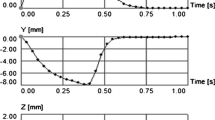Abstract
Purpose.
We present our initial clinical experience with a recently introduced 64-detector computed tomography (64-MDCT) scanner that makes use of a periodic motion of the focal spot in the longitudinal direction (z-flying focal spot), which enables it to reach a final spatial resolution of 0.4×0.4×0.4 mm3 and a temporal resolution of 83 ms.
Materials and methods.
A total of 114 patients (108 men, six women; age range 36–77 years, mean 63.1 years) underwent retrospective electrocardiogram (ECG)-gated examination of the coronary arteries using a 64-MDCT scanner (Somatom Sensation 64, Siemens Medical Solutions, Germany). Acquisition parameters were the following: collimation 64×0.6 mm, 800 quality reference milliampere second (mAs), 120 kVp, 0.33-s gantry rotation time and pitch 0.2. Images were acquired in all cases after i.v. administration of 80 ml of contrast agent (Iomeron 400 mgI/dl, Bracco, Italy) + 30 ml of saline at 4 /s and delay time determined using a bolus triggering technique. Oral betablockers were administered to patients with heart rate (HR) >75 bpm. To reduce radiation exposure, an automatic exposure control system was applied in all cases to adapt tube current to patient size and anatomic shape (CARE Dose 4D, Siemens Medical Solutions, Germany). The optimal temporal window for raw data reconstruction was chosen from an initial preview of images reconstructed with different phase settings (range 0%–95% RR interval with 5% gap) at a selected anatomical level in the mid part of the right coronary artery. CT dose index volume and effective dose were quantified in all patients using dedicated software.
Results.
Mean HR recorded during image acquisition was 65.6±19.2 bmp (range: 44–96 bmp), and beta-blockers were administered to 16/114 patients (14.0%). Technical adequacy was achieved in all patients but two (2/114; 1.7%). In patients with HR <60 bmp, the best reconstruction intervals were identified in the end-systolic (30%–35% of the RR interval) and end-diastolic (60%–65% of the RR interval) phases; with faster HR (>80 bmp), high image quality was observed in end-systole (30%–35% of the RR interval). Mean CT dose index (CTDI) volume was 36.53±8.30 mGy per patient. In comparison with a conventional examination with fixed mAs, the use of the CARE Dose 4D system provided a 33.3% CTDI volume reduction (p<0.001). Mean effective dose was 9.5±3.4 millisievert (mSv) per patient (range 7.1–17.7).
Conclusions.
The 64-MDCT scanner diagnostic performance for coronary CT angiography is further improved with better spatial and temporal resolution and faster scan times; besides, initial clinical results are promising. The use of dose-reducing acquisition techniques is mandatory to limit radiation exposure to the patient.
Similar content being viewed by others
Author information
Authors and Affiliations
Corresponding author
Rights and permissions
About this article
Cite this article
Francone, M., Napoli, ., Carbone, I. et al. Noninvasive imaging of the coronary arteries using a 64-row multidetector CT scanner: initial clinical experience and radiation dose concerns. Radiol med 112, 31–46 (2007). https://doi.org/10.1007/s11547-007-0118-8
Received:
Accepted:
Published:
Issue Date:
DOI: https://doi.org/10.1007/s11547-007-0118-8




